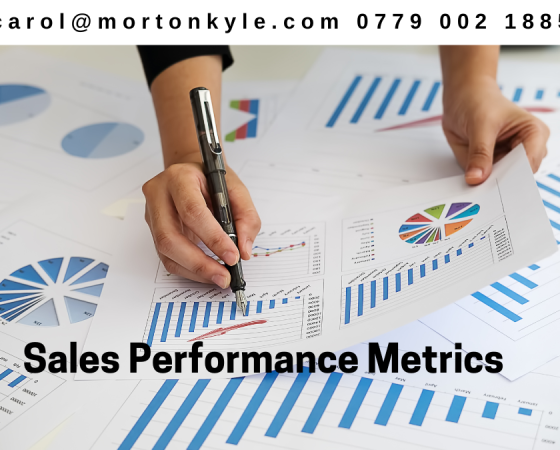Sales Metrics and Sales Key Performance Indicators matter a great deal when you’re striving to understand the nuts and bolts of your sales function.
They are critical for any form of sales performance improvement, introducing sales performance management or continuous sales improvement or if you’re simply looking for higher sales results.
Getting the right metrics, measured in the right way, at the right frequency is the difference between guaranteed success and tying yourself in knots!
Not least because of the need to measure what you’re doing before you start any form of sales improvement initiative is an absolute must (but you’d be surprised how many organisations don’t think to do this!)
Another critical reason to get a smart handle on your sales improvement metrics is that no-one needs to wait until the end of the month to review the month – again, you’d be surpised at how many organisations will ‘let the month happen TO them, and then wait for month-end to do the post-mortem!
(Quick note – you are still in that scary position of waiting until the end of the month, then you might want to pop over here and Learn How to Escape the Month End Panic )
So, we’ve established there are handfuls of great reasons why having the right team sales KPI’s and the right individual sales metrics under your control, not least that it means your chances of achieving improved sales results is increased
So. let’s go, the following will help you identify some of the challenges around this area.
What Sales Metrics to Use?
When you’re thinking about sales metrics, ask yourself this
What is it exactly you’re trying to achieve?
Once you’ve established that – break it down into daily tasks and activities that need to be done to achieve those goals.
For example – you want a sales person in your team to book 2 sales appointments per day…then look at their sales performance to date…
You know their hit rate from cold to booked appointment/demo is 10%
So, he needs to speak to 20 people / quality decision makers per day
So that’s the really easy bit.
That’s simple management by numbers….we don’t focus on this so much now BECAUSE it’s the minimum stakes of any sales person in a targeted role – they have to make the activity minimums!
A simple sales route map to get you from where you are today (maybe he’s only booking 1 appointment per day because he’s only prospecting 10 quality decision makers per day)
And that’s the easiest way to start.
Double his activity, BUT if this is the only thing you do, you’re driving a car using just the very basic of gears.
To really ratchet performance there is a world of key performance indicators that would definitely help you (and your sales team) hit their sales quota based on setting some simple daily, hourly, weekly sales goals…and knowing what factors impact those mini-sales goals.
Not only will knowing this drive sales performance, they introduce the element of progress snd gamification on what can often be thought of a sales treadmill.
After all, who doesn’t like an element of competitiveness in a sales team?
Nothing drives success like success!
Having mini sales goals and key performance indicators measure success, and all you and the team to continually shift focus depending on what’s working and what could work better.
Sales improvement is a team activity. The key to great sales performance management initiatives is that the sales leader doesn’t need to drive them – the accountability to deliver sits with the sales person themselves…meaning the sales leader can really step into the role of sales coach in a servant leadership style.
So, What Do These Sales Key Performance Indicators Look Like?
Well. first of all that depends on what you want to achieve.
Let’s imagine a telesales team / appointment setting team…
For example, if your primary aim is to drive activity then there are key sales insights you’ll want to consider, all around helping you work out the very best Sales Recipe
- How much data is available?
- How much of that data has been called more than 7 times? (old data)
- What quantity of fresh data do you have?
- How does the conversion rate differ from old to fresh data?
- What are the most productive hours for calling?
- What are the most productive hours for admin?
- How do the conversion rates differ with prospects who have been called / sent info vs those prospects that converted from cold?
- What’s the cancellation rate on booked appointments?
- Is it worth rebooking cancelled appointments?
- How many calls do you make to typically get an appointment booked?
- How many of your appointments go on to close within 1 week?
- Average call duration for a successful call versus and non-successful call?
- Average admin time per call?
- Contact rate for your industry – i.e. ratio of decision maker call/gate keeper call
- How many dials do you do per hour?
- How many decision makers do you pitch to per hour?
- What are the common objections you get and how are you over coming them?
- What data source/lead list gives you the best conversion rate to appointment and the best conversion rate to deal signed?
This is not an exhaustive list, but you’ll get a picture for how you create your very best Sales Recipe template for you.
Now you can set up your sales metrics and sales key performance indicator template
BUT don’t set up metrics for the sake of it.
Not every metric needs to be measured!
Ask yourself; if you had to identify the most critical sales improvement, profit improvement, sales performance improvement sales metric then what would it be, then monitor that by reviewing the intrinsic parts.
Here’s why
Any sales person can double the number of appointments they book.
That’s easy.
The critical bit from a sales management point of view is looking at booking high quality sales appointments
If this is an area you are struggling with them check out T – How to Book High Quality, Well Qualified Sales Appointments that Close
So, the number of appointments booked is one factor, but what if all those sales appointments were absolute rubbish quality? Well, it looks good on paper BUT falls like a house of cards…
You have to look further down the line for ‘quality indicators’ so maybe look at hjow many books appointments show up for the appointment
Then look at how many fit the criteria to be worthy of getting a quote
Then maybe, look at how amny get contracts sent out…
All of these elemenst will give you a granular sales improvement oversight, so you cam see where the holes are, highlighting what’s impacting your sales success
Any way, on with broader sales metrics…
Often one of the first and biggest piece of work done in any sales turnaround or sales performance improvement is to agree to measure those sales metrics that have a direct relationship to sales success.
The sales metrics you can control.
The sales metrics you can influence.
Influence daily. hourly even in many cases.
Metrics like:
- Dial rate
- Conversion from different lead sources
- Contact rate
- Activity during key hours
- Call duration
- Total talk time
- Opportunities to book that booked
- Opportunities to book that failed
Sales Performance Improvement is so much more
BUT – the above sales metrics are meaningless in isolation – they have to be looked at in the context of:
- The rest of the sales team
- The sales insights you detailed above
- Your sales strategy
- The total market
- The total addressable market
- The maturity of the sales function
- The value proposition
- The competitive market space
- The workload of the sales function
Your aim is to
- Not just to spin the sales wheel faster – talk to more people – BUT to optimise the sales operation
- Improve the quality of the conversation
- Improve the quality of the prospect outreach
- Fine tine the value proposition
- Systematically repel competitors
- Increase contact rates through additional outreach
- Operate as a lighthouse to attract
- Remove elements of the sales process that cause friction
- Cancel elements of the sales process that fail to deliver value
- Continually refine and review the sales pitch
- Get super-smart about dealing with objections
The list could go on and on….
That’s both quality and quantity measures to increase the chances of success in terms of conversion to appointment and from appointment to order, from demo booked to quote to close, from lead in to lead closed…
Sales insights are critical to success here – they form the basis of your improvement conversations with the team, getting them onboard and aligning goals, sales strategy and sales results – knowing your sales metrics in context with your sales insights help you find your perfect sales recipe for everyone.
Sales Performance Management: Why Use Sales Metrics?
Lots of reasons, primarily it’s an indicator for the sales management and the sales people that you’re all on the same track. Great sals metrics create the best environment for relly constructive and positive discussions about ongoing performance improvement!
Carefully monitoring and flexing the right sales metrics reduces stress as you know you’re in control. It makes sales forecasting a breeze – check out Simple Sales Forecasts
Plus confidence soars when everyone knows you’ve got everything you need to succeed!
Plus it’s a way of measuring sales progress when the month, week, day is still in play…and while you’ve still got a chance to change the final score.
Check out more on this Using Sales Results Using Key Performance Indicators
And, if you’re a sales person, you know you’ll earn bonus, and if not you’ve got some idea of what to do to change that.
If you’re a sales manager, you know what skills to re-coach and with who.
And if you’re the business owner, you don’t have to wait 2 weeks after the month end to discover how much money you’ve made, or not made, as the case may be.
Agile use of your sales metrics is the easiest, quickest and most efficient way to improve sales skills, sales motivation, engagement with your sales people, improved sales function performance and bottom line profits.
The key to continuous sales improvement.
Plus…
Sales Performance Management: Sales Metrics to Engage Everyone Every Day!
Whether you’re using a league table, a weekly sales meeting, a daily sales huddle, everyone is following the same road map…no-one is out there on their own.
Everyone is working with the same sign posts and with a supported and directed mission to get there!
Everyone wants to know their results, everyone else’s results.
Are they winning, nearly winning, lagging behind?
Information is power.
Power to change direction, recalibrate, restart.
Better can only get better if the route to success is being monitored and fed back. Iterated and counted.
When to Proactively Use Sales Metrics?
That’s simple…
Use your sales insights and your sales metrics every day.
Both the team sales metrics/sales KPI’s and the individual numbers.
This is the epitome of success in hands on sales management and sales leadership.
It will focus everyone’s attention on what’s not happening that should be happening.
It helps if you launch that months sales metrics at the beginning of the month. Explain why you’ve selected these metrics. Explore what success looks like, what disaster looks like. Highlight what support the business is providing to help everyone get where they need.
Then you’ve set the premise of expectations, it’s your management guide map for the month.
Your reference point.
Your true north.
These sales KPI’s can then be reported/reference daily via huddles, emails, leader board, office screen, 121 sales coaching.
How to Use Your Sales Metrics in Personal Improvement Plans and Performance Management Frameworks…
Your selected sales metrics and sales KPI’s are also part of every sales persons sales review.
They form part of every performance management and sales development plan, personal development plan.
Used to drive performance, striving for continuous improvement.
They can also highlight areas where sales training, coaching, shadowing, mentoring or additional support is required.
To foster team spirit and collective sales team focus for the good of the individuals and the business.
A reason to celebrate sales success.
As well as giving a team platform for discussion and suggestions.
Collective learning, ideal for targeted buddying.
Sales Metrics Matter…but that’s not all
Of course, it’s not all.
No-one manages solely by numbers any more.
Numbers, sales metrics, sales KPI’s well they’re just the foundations. Keeping score.
The real winning benefit is how the sales leadership team use these metrics. Great sales leaders use them to interact, develop, coach and motivate the team…that’s why using your sales metrics in partnership with the sales insights is ideal.
Having worked with thousands of sales people, I know for sure that the fastest way to improve sales performance is to spend more time coaching and mentoring the sales team.
Having great clarity and shared ownership of group and individual sales metrics/sales KPI’s is the easiest way to do just that.
Also if you’re really serious about improving sales results within your business, hit the links below:
The Sales Improvement Workshop – the fastest way to refocus, re-energise and improve sales results.
Sales Audit – for when you want to improve sales results, turnover and profits, but have no idea where to start.
And, if you’re great at getting sales quotes out, but your buyer’s all seem to disappear when you follow up the sales quite check this out Buyer Gone AWOL – Following Up Sales Quotes
To discuss your specific sales training and sales improvement needs you can contact us on 0779 002 1885
Remember, having the right sales metrics that allows you to use positive and proactive sales performance management is critical to any sales function wanting to outperform competitors, drive margins and foster continuous sales improvement.

Hi, welcome to Morton Kyle Limited.
As Founder and Lead Consultant, I’ve spent the last 30+ years in the trenches of sales—fixing broken pipelines, rebuilding underperforming teams, and helping businesses close more deals at higher margins.
I’ve worked with global brands, challenger firms, and fast-growth sales teams, helping them:
✔ Fix underperforming pipelines – turning ghosted leads into closed deals.
✔ Increase win rates – without discounting or chasing bad-fit prospects.
✔ Build sales systems that actually work – so you don’t waste time on ‘busy work’ that doesn’t convert.
I’m not another ‘sales trainer.’ I don’t teach theory. I fix sales problems – fast. And if you’re still reading, it means you’ve got a problem that needs fixing.
I know how sales leaders think because I’ve been one. I know what the board wants because I’ve sat in those meetings.
And I know what works – because I’ve done it, tested it, and proved it across industries, markets, and economic downturns.



Comments are closed.